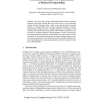Free Online Productivity Tools
i2Speak
i2Symbol
i2OCR
iTex2Img
iWeb2Print
iWeb2Shot
i2Type
iPdf2Split
iPdf2Merge
i2Bopomofo
i2Arabic
i2Style
i2Image
i2PDF
iLatex2Rtf
Sci2ools
ICANN
2009
Springer
2009
Springer
Constrained Learning Vector Quantization or Relaxed k-Separability
Neural networks and other sophisticated machine learning algorithms frequently miss simple solutions that can be discovered by a more constrained learning methods. Transition from a single neuron solving linearly separable problems, to multithreshold neuron solving k-separable problems, to neurons implementing prototypes solving q-separable problems, is investigated. Using Learning Vector Quantization (LVQ) approach this transition is presented as going from two prototypes defining a single hyperplane, to many co-linear prototypes defining parallel hyperplanes, to unconstrained prototypes defining Voronoi tesselation. For most datasets relaxing the co-linearity condition improves accuracy increasing complexity of the model, but for data with inherent logical structure LVQ algorithms with constraints significantly outperforms original LVQ and many other algorithms.
| Added | 25 Jul 2010 |
| Updated | 25 Jul 2010 |
| Type | Conference |
| Year | 2009 |
| Where | ICANN |
| Authors | Marek Grochowski, Wlodzislaw Duch |
Comments (0)

